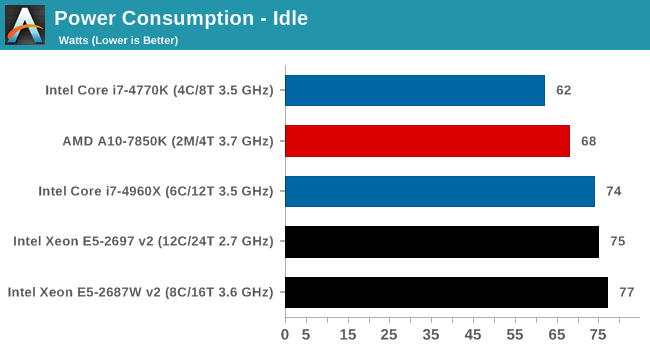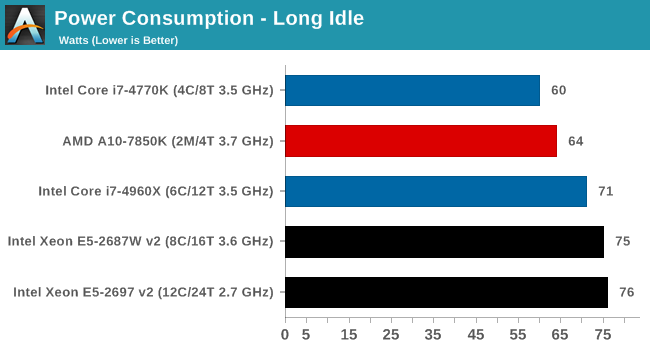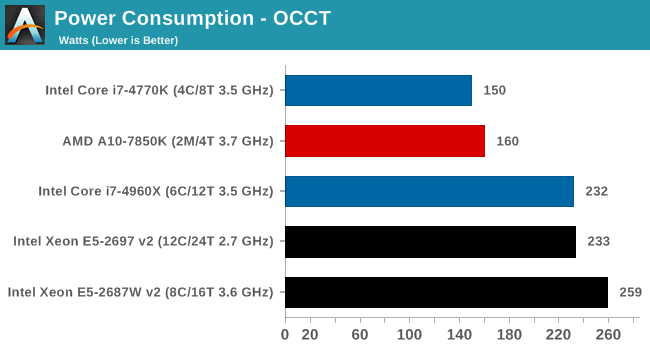Intel Xeon E5-2697 v2 and Xeon E5-2687W v2 Review: 12 and 8 Cores
by Ian Cutress on March 17, 2014 11:59 AM EST- Posted in
- CPUs
- Intel
- Xeon
- Enterprise
The Mac Pro (Late 2013)
When Anand reviewed the Mac Pro late last year, he received the full fat 12 core edition, using the E5-2697 v2 CPU with a 2.7 GHz rating. The CPU choices for the Mac Pro include 4, 6 and 8 core models, all with HyperThreading. Interestingly enough, the 4/6/8 core models all come from the E5-16xx line, meaning the CPUs are designed with single processor systems in mind. But to get to the 12 core/24 thread model at the high end, Apple used the E5-2697 v2, a processor optimized for dual CPU situations. Based on the die shots on the previous page, this has repercussions, but as Anand pointed out, it all comes down to power usage and turbo performance.
| Mac Pro (Late 2013) CPU Options | ||||||
| Intel CPU | E5-1620 v2 | E5-1650 v2 | E5-1680 v2 | E5-2697 v2 | ||
| Cores / Threads | 4 / 8 | 6 / 12 | 8 / 16 | 12 / 24 | ||
| CPU Base Clock | 3.7GHz | 3.5GHz | 3.0GHz | 2.7GHz | ||
| Max Turbo (1C) | 3.9GHz | 3.9GHz | 3.9GHz | 3.5GHz | ||
| L3 Cache | 10MB | 12MB | 25MB | 30MB | ||
| TDP | 130W | 130W | 130W | 130W | ||
| Intel SRP | $294 | $583 | ? | $2614 | ||
The Mac Pro is designed within a peak 450W envelope, and Intel has options with its CPUs. For the same TDP limit, Intel can create many cores as low frequency, or fewer cores at higher frequency. This is seen in the options on the Mac Pro – all the CPU choices have the same 130W TDP, but the CPU base clocks change as we rise up the core count. Moving from 4 cores to 8 cores keeps the maximum turbo (single core performance) at 3.9 GHz, but the base clock decreases the more cores are available. Finally at the 12-core model, the base frequency is at its lowest of the set, as well as the maximum turbo.
This has repercussions on workloads, especially for workstations. For the most part, the types of applications used on workstations are highly professional, and have big budgets with plenty of engineers designed to extract performance. That should bode well for the systems with more cores, despite the frequency per core being lower. However, it is not always that simple – the mathematics for the problem has to be able to take advantage of parallel computing. Simple programs run solely on one core because that is the easiest to develop, but if the mathematics wholly linear, then even enterprise software is restricted. This would lend a positive note to the higher turbo frequency CPUs. Intel attempts to keep the turbo frequency similar as long as it can while retaining the maximum TDP to avoid this issue; however at the 12-core model this is not possible. Quantifying your workload before making a purchase is a key area that users have to consider.
Benchmark Configuration
I talk about the Mac Pro a little because the processors we have for a ‘regular’ test today are 8-core and 12-core models. The 12-core is the same model that Anand tested in the Mac Pro – the Xeon E5-2697v2. The 8-core model we are testing today is different to the one offered in the Mac Pro, in terms of frequency and TDP:
| Intel SKU Comparison | |||
| Core i7-4960X | Xeon E5-2687W v2 | Xeon E5-2697 v2 | |
| Release Date | September 10, 2013 | September 10, 2013 | September 10, 2013 |
| Cores | 6 | 8 | 12 |
| Threads | 12 | 16 | 24 |
| Base Frequency | 3600 | 3400 | 2700 |
| Turbo Frequency | 4000 | 4000 | 3500 |
| L3 Cache | 15 MB | 25 MB | 30 MB |
| Max TDP | 130 W | 150 W | 130 W |
| Max Memory Size | 64 GB | 256 GB | 768 GB |
| Memory Channels | 4 | 4 | 4 |
| Memory Frequency | DDR3-1866 | DDR3-1866 | DDR3-1866 |
| PCIe Revision | 3.0 | 3.0 | 3.0 |
| PCIe Lanes | 40 | 40 | 40 |
| Multi-Processor | 1P | 2P | 2P |
| VT-x | Yes | Yes | Yes |
| VT-d | Yes | Yes | Yes |
| vPro | No | Yes | Yes |
| Memory Bandwidth | 59.7 GB/s | 59.7 GB/s | 59.7 GB/s |
| Price | $1059 | $2112 | $2618 |
The reason for this review is to put these enterprise class processors through the normal (rather than server) benchmarks I run at AnandTech for processors. Before I started writing about technology, as an enthusiast, it was always interesting to hear of the faster Xeons and how much that actually made a difference to my normal computing. I luckily have that opportunity and would like to share it with our readers.
The system set up is as follows:
| Test Setup | |
| Motherboards |
GIGABYTE GA-6PXSV3 MSI X79A-GD45 Plus for 3x GPU Configurations |
| Memory | 8x4 GB Kingston DDR3-1600 11-11-11 ECC |
| Storage | OCZ Vertex 3 256 GB |
| Power Supply | OCZ 1250 ZX Series |
| CPU Cooler | Corsair H80i |
| NVIDIA GPU | MSI GTX 770 Lightning 2GB |
| AMD GPU | ASUS HD 7970 3GB |
Many thanks to...
We must thank the following companies for kindly providing hardware for our test bed:
Thank you to GIGABYTE Server for providing us with the Motherboard and CPUs
Thank you to OCZ for providing us with 1250W Gold Power Supplies and SSDs.
Thank you to Kingston for the ECC Memory kit
Thank you to ASUS for providing us with the AMD HD7970 GPUs and some IO Testing kit.
Thank you to MSI for providing us with the NVIDIA GTX 770 Lightning GPUs.
Power Consumption
Power consumption was tested on the system as a whole with a wall meter connected to the OCZ 1250W power supply, while in a single MSI GTX 770 Lightning GPU configuration. This power supply is Gold rated, and as I am in the UK on a 230-240 V supply, leads to ~75% efficiency > 50W, and 90%+ efficiency at 250W, which is suitable for both idle and multi-GPU loading. This method of power reading allows us to compare the power management of the UEFI and the board to supply components with power under load, and includes typical PSU losses due to efficiency. These are the real world values that consumers may expect from a typical system (minus the monitor) using this motherboard.
While this method for power measurement may not be ideal, and you feel these numbers are not representative due to the high wattage power supply being used (we use the same PSU to remain consistent over a series of reviews, and the fact that some boards on our test bed get tested with three or four high powered GPUs), the important point to take away is the relationship between the numbers. These boards are all under the same conditions, and thus the differences between them should be easy to spot.



At idle, the Xeons are on par with the Core i7-4960X for power consumption in the GIGABYTE motherboard. At load the extra TDP of the E5-2687W v2 can be seen.
DPC Latency
Deferred Procedure Call latency is a way in which Windows handles interrupt servicing. In order to wait for a processor to acknowledge the request, the system will queue all interrupt requests by priority. Critical interrupts will be handled as soon as possible, whereas lesser priority requests, such as audio, will be further down the line. So if the audio device requires data, it will have to wait until the request is processed before the buffer is filled. If the device drivers of higher priority components in a system are poorly implemented, this can cause delays in request scheduling and process time, resulting in an empty audio buffer – this leads to characteristic audible pauses, pops and clicks. Having a bigger buffer and correctly implemented system drivers obviously helps in this regard. The DPC latency checker measures how much time is processing DPCs from driver invocation – the lower the value will result in better audio transfer at smaller buffer sizes. Results are measured in microseconds and taken as the peak latency while cycling through a series of short HD videos - less than 500 microseconds usually gets the green light, but the lower the better.

The DPC latency of the Xeons is closer to the 100 mark, which we saw during Sandy Bridge. Newer systems seem to be increasing the DPC latency - so far all Haswell consumer CPUs are at the 140+ line.










71 Comments
View All Comments
lever_age - Monday, March 17, 2014 - link
Ian, the Xeon E3-1220v3 and E3-1225v3 do not have hyperthreading. They're incorrectly listed in the table as 4c/8t. At those prices, if they did have 8t, more people would be buying them! Also, I think that "c3" by the E3-1230 is a typo.Ian Cutress - Monday, March 17, 2014 - link
Correct, I missed that going through the data.psyq321 - Monday, March 17, 2014 - link
"If the E5-2697 v2 was put in this position, we would have 12 cores at 3.5 GHz, ready to blast through the workload."I do not think this is possible. I have tried to force all cores to turbo mode with ThrottleStop on the 2697v2 Xeon (ThrottleStop bypasses the BIOS/UEFI and codes the limits directly using MSR registers), but the CPU will just refuse to grant this.
I suppose the desktop CPUs simply have this option unlocked, while 2S/4S Xeons have much stricter operating point limits.
The best I can do with 2697 v2 is to set the BCLK to 105 MHz with Z9PE-D8 WS and get 3.15 GHz maximum all-core turbo. This is as much overclock as the system can take.
Ian Cutress - Monday, March 17, 2014 - link
I've managed to get 110 BCLK on both processors relatively stable (112 BCLK needs a push), but this boosts up from the lower multiplier rather than the high one, and there is still a deficit on the high end. Enthusiasts will always want more, and I'd love the chance to run all the cores at the top turbo mode. Given how this is on the consumer line, it makes me wonder why Intel doesn't allow it here. The downside on the consumer line of allowing this behaviour is every so often there is a motherboard that fails to implement any Turbo Core, which has happened in my testing already.psyq321 - Monday, March 17, 2014 - link
I suppose some Intel marketing people just wanted to stop a possibility of lower-end Xeon cannibalizing higher-end Xeons by cheap overclocking. There are markets even in server business that are OK with overclocking (low latency trading, for example).It is interesting that you got it to 110 MHz BCLK. Did you use a server/workstation board or a HEDT (X79) board?
Ian Cutress - Monday, March 17, 2014 - link
This was in the MSI X79A-GD45 Plus, an X79 board. There are some server market areas that do sell pre-overclocked systems in this way, while still using Xeons, if I remember correctly.psyq321 - Monday, March 17, 2014 - link
I think HEDT boards are better when it comes to overclocking, probably due to higher component tolerances.Z9PE-D8 WS is not that good, but then again, it is a 2S board and apart from some Supermicro products (the "hyperspeed" series), the only 2S board that allows at least some overclocking of DDR3 and CPU.
Slomo4shO - Monday, March 17, 2014 - link
I am perplexed by the gaming benchmarks... Any particular reason why the 4770K and A10-7850K don't show up on all of the single and double GPU benchmarks? Especially considering that you have some tri-fire benches of the a10-7850K...Ian Cutress - Monday, March 17, 2014 - link
The AMD does not allow dual NVIDIA cards because the platform does not allow SLI. I need to re-run the 4770K in a PLX8747 enabled motherboard to get 3x SLI results across the board (you cannot get 3x SLI without a PLX chip), and I have not had a chance to run either CPU on my BF4 benchmark which has just been finalised for this review. The A10-7850K and i7-4770K numbers were taken from the Kaveri review and some internal testing - now my 2014 benchmarks are finalised I can run it on more platforms as the year goes on.et20 - Monday, March 17, 2014 - link
Why aren't Xeon E3s the recommended CPUs for enthusiast desktops?They make more sense than the Core i5 and i7 which come with integrated graphics that never gets used.